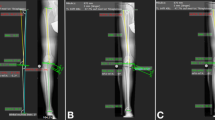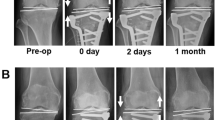Abstract
High tibial osteotomy is an established technique for the treatment of varus malaligned knees. This study analyses the difference between the amount of correction in the preoperative planning and the postoperative result. Furthermore, it compares the difference of the accuracy between open-wedge osteotomy and closed-wedge osteotomy. About 61 patients were either treated with open-wedge or closed-wedge high tibial osteotomy. Preoperative planning and postoperative analysis were performed with a special planning software. The influence of operative technique, aetiology, age, number of previous surgeries, amount of correction and accuracy of the correction compared to the preoperative planning were analysed. The overall postoperative mechanical axis differed form preoperative planning by 2.1° ± 1.7°. The accuracy in the open-wedge group (1.7° ± 1.6°) was significantly higher than in the closed-wedge group (2.6° ± 1.8°; P = 0.038). In patients with congenital varus deformity, the accuracy of the correction was significantly higher than in patients with post-traumatic deformity. The authors recommend open-wedge technique in combination with fixed-angle plates for high tibial osteotomy.




Similar content being viewed by others
References
Agneskircher JD, Freiling D, Hurschler C et al (2006) Primary stability of four different implants for opening wedge high tibial osteotomy. Knee Surg Sports Traumatol Arthrosc 14:291–300
Baums MH, Esenwein SA, Klinger HM (2005) An open wedge head osteotomy using continuous callus distraction. An alternative method for the treatment of varus arthrosis. Unfallchirurg 108:43–48
Bonnin M, Chambat P (2004) Der Stellenwert der valgisierenden, zuklappenden Tibiakopfosteotomie bei der medialen Gonarthrose. Orthopäde 33:135–142
Brouwer RW, Bierma-Zeinstra SM, van Raaij TM et al (2006) Osteotomy for medial compartment arthritis of the knee using a closing wedge or an opening wedge controlled by a Puddu plate. A one-year randomised, controlled study. J Bone Joint Surg Br 88:1454–1459
Coventry MB (1979) Upper tibial Osteotomy for gonarthrosis. The evolution of the operation in the last 18 years and long term results. Orthop Clin North Am 10:191–210
Coventry MB, Ilstrup DM, Wallrichs SL (1993) Proximal tibial Osteotomy. A critical long-term study of eighty-seven cases. J Bone Joint Surg Am 75:196–201
Fujisawa Y, Masuhara K, Shiomi S (1979) The effect of high tibial Osteotomy on osteoarthritis of the knee. An arthroscopic study of 54 knee joints. Orthop Clin North Am 10:585–608
Gaasbeek R, Welsing R, Verdonshot N et al (2005) Accuracy and initial stability of open- and closed-wedge high tibial osteotomy: a cadaveric RSA study. Knee Surg Sports Traumatol Arthrosc 13:689–694
Galla M, Lobenhoffer P (2004) High tibial open wedge valgus osteotomy stabilized with the TomoFix® plate fixator. Operat Orthop und Traumatol 16:397–417
Hankemeier S, Gösling T, Richter M et al (2006) Computer-assisted analysis of lower limb geometry: higher intraobserver reliability compared to conventional method. Comput Aided Surg 11:81–86
Hankemeier S, Hüfner T, Wang G et al (2006) Navigated open wedge high tibial osteotomy: advantages and disadvantages compared to the conventional technique in a cadaver study. Knee Surg Sports Traumatol Arthrosc 14:917–921
Hernigou P, Medevielle D, Debeyre J et al (1987) Proximal tibial osteotomy for osteoarthritis with varus deformity. A ten to thirteen-year follow up study. J Bone Joint Surg Am 69:332–354
Hoell S, Suttmoeller J, Stoll V et al (2005) The high tibial osteotomy, open versus closed wedge a comparison of methods in 108 patients. Arch Orthop Trauma Surg 125:638–643
Hsu RW, Himeno S, Coventry MB et al (1990) Normal axial alignment of the lower extremity and loadbearing distribution at the knee. Clin Orthop 255:215–227
Kendoff D, Board TN, Citak M et al (2008) Navigated lower limb axis measurements: influence of mechanical weight-bearing simulation. J Orthop Res 26:553–561
Kettelkamp DB, Wenger DR, Chao EY et al (1976) Results of proximal tibial osteotomy. The effects of tibiofemoral angle, stance-phase flexion-extension, and medial-plateau force. J Bone Joint Surg Am 58:952–960
Koschino T, Morii T, Wada J et al (1989) High tibial osteotomy with fixation by a blade plate for medial compartment osteoarthritis of the knee. Orthop Clin North Am 20:227–243
Krettek C, Miclau T, Grün O et al (1998) Intraoperative control of axes, rotation and length in femoral and tibial fractures. Technical note. Injury 29:29–39
Leutloff D, Tobian F, Perka C (2001) High tibial osteotomy for valgus and varus deformities of the knee. Int Orthop 25:93–96
Lobenhoffer P, Agneskirchner JD (2003) Improvements in surgical technique of valgus high tibial osteotomy. Knee Surg Sports Traumatol Arthrosc 11:132–138
Lobenhoffer P, Simoni CD, Staubli AE (2002) Open-wedge high tibial osteotomy with rigid plate fixation. Tech Knee Surg 2:1–11
Magyar G, Toksvig-Larsen S, Lindstrand A (1998) Open wedge osteotomy by callus distraction in gonarthrosis: operative technique and early results in 36 patients. Acta Orthop Scand 69:147–151
Müller W, Kentsch A, Schafer N (2000) The elastic high tibia valgus Osteotomy in the varus deformity. Oper Tech Sports Med 8:19–26
Nakamura E, Mizuta H, Kudo S et al (2001) Open-wedge osteotomy of the proximal tibia hemicallotasis. J Bone Joint Surg Br 83:1111–1115
Paley D (2001) Realignment for mono-compartment osteoarthritis of the Knee. In: Principles of deformity correction. Springer, Berlin/Heidelberg/New York, pp 479–485
Paley D, Herzenberg JE, Tetsworth K et al (1994) Deformity planning for frontal and sagittal plane corrective osteotomies. Orthop Clin North Am 25:425–465
Pape D, Adam F, Rupp S et al (2004) Stabilität, Knochenheilung und Korrekturverlust nach valgisierender Tibiakopfumstellung. Orthopäde 33:208–217
Pascher A, Materna W, Windhager R (2003) Analysis of two different techniques of osteosynthesis in high tibial osteotomy. Z Orthop Ihre Grenzgeb 141:37–41
Sharma L, Song J, Felson DT et al (2001) The role of knee alignment in disease progression and functional decline in knee osteoarthritis. JAMA 286:188–195
Sprenger TR, Doerzbacher JF (2003) Tibial osteotomy for the treatment of varus gonarthrosis. Survival and failure analysis to twenty-two years. J Bone Joint Surg Am 85A:469–474
Staubli AE, De Simoni C, Babst R et al (2003) TomoFix: a new LCP-concept for open wedge osteotomy of the medial proximal tibia—early results in 92 cases. Injury 34(Suppl 2):55–62
Trieb K, Grohs J, Hanslik-Schnabel B et al (2006) Age predicts outcome of high tibial osteotomy. Knee Surg Sports Traumatol Arthrosc 14:149–152
Conflict of interest statement
The authors declare that they have no conflict of interest. All authors disclose any financial or personal relationship with other people or organizations. The presentation of the issue is independent.
Author information
Authors and Affiliations
Corresponding author
Rights and permissions
About this article
Cite this article
Hankemeier, S., Mommsen, P., Krettek, C. et al. Accuracy of high tibial osteotomy: comparison between open- and closed-wedge technique. Knee Surg Sports Traumatol Arthrosc 18, 1328–1333 (2010). https://doi.org/10.1007/s00167-009-1020-9
Received:
Accepted:
Published:
Issue Date:
DOI: https://doi.org/10.1007/s00167-009-1020-9




